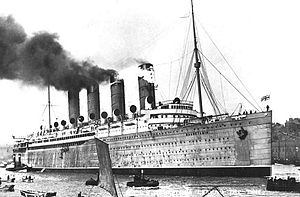 Mauretania in 1907 on the Tyne
| |
| History | |
|---|---|
| Name | Mauretania |
| Namesake | Mauretania |
| Owner | 1906–1934: Cunard Line 1934–1935: Cunard White Star Line |
| Operator | |
| Port of registry | |
| Route | Liverpool–Queenstown–New York (1907–1919) Southampton–Cherbourg–New York (1919–1934) |
| Ordered | 1904 |
| Builder | Swan Hunter, Northumberland, England |
| Yard number | 735 |
| Laid down | 18 August 1904 |
| Launched | 20 September 1906 |
| Christened | 20 September 1906, by the Duchess of Roxburghe |
| Acquired | 11 November 1907 |
| Maiden voyage | 16 November 1907 |
| In service | 1907–1934 |
| Out of service | September 1934 |
| Identification | Wireless call sign: MGA (until 1934) |
| Fate | Scrapped in 1935 at Rosyth, Scotland |
| General characteristics | |
| Type | Ocean liner |
| Tonnage | 31,938 GRT, 12,797 NRT |
| Displacement | 44,610 tons |
| Length | 790 ft (240.8 m) |
| Beam | 88 ft (26.8 m) |
| Draft | 33 ft (10.1 m) |
| Depth | 33 ft 6 in (10.2 m) |
| Decks | 8 |
| Installed power |
|
| Propulsion | Quadruple propeller installation |
| Speed | 25 kn (46 km/h; 29 mph) ‐ 28 kn (52 km/h; 32 mph) design service speed |
| Capacity |
|
| Crew | 802 |
| Notes | Largest ship in the world from 1907–1910. Running mate to RMS Lusitania and RMS Aquitania |
RMS Mauretania was a British ocean liner designed by Leonard Peskett and built by Swan Hunter and Wigham Richardson on the River Tyne, England for the Cunard Line, launched on the afternoon of 20 September 1906. She was the world's largest ship until the launch of RMS Olympic in 1910. Mauretania captured the eastbound Blue Riband on the maiden return voyage in December 1907, then claimed the westbound Blue Riband for the fastest transatlantic crossing during her 1909 season. She held both speed records for 20 years.[1]
The ship's name was taken from the ancient Roman province of Mauretania on the northwest African coast, not the modern Mauritania to the south.[2] Similar nomenclature was also employed by Mauretania's running mate Lusitania, which was named after the Roman province directly north of Mauretania, across the Strait of Gibraltar[2] in Portugal. Mauretania remained in service until September 1934, when Cunard-White Star retired her; scrapping commenced in Rosyth, in 1935.